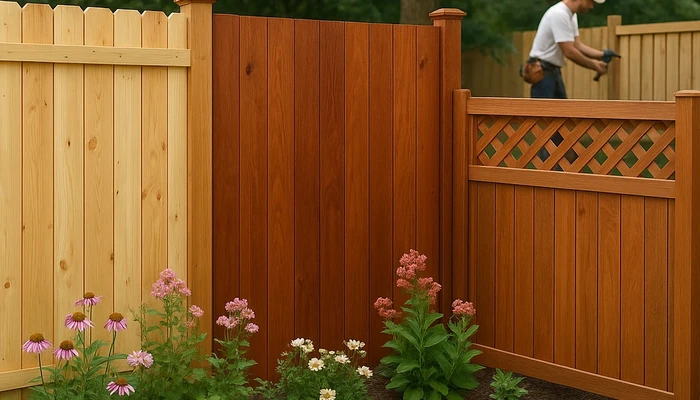The Best Wood Types for Fencing: A Practical Guide
Choosing the ideal types of wood for fencing is essential for any homeowner, property manager, or general contractor looking to create a durable, attractive boundary. With Chicago’s challenging winters and variable weather, wood selection impacts not only curb appeal but longevity, pet safety, costs, and fence maintenance needs.
Factors to Consider When Choosing Fence Wood
Each wood type offers unique benefits. Before you decide, consider durability, resistance to rot and pests, maintenance, up-front cost, and performance during harsh Chicago and suburban winters. Balancing these factors helps you pick the fence that best matches your property’s needs.
Popular Wood Types for Fencing
| Wood Type | Durability | Cost | Winter Suitability |
|---|---|---|---|
| Cedar | Very Good | $$ | Excellent |
| Pine (Pressure Treated) | Good | $ | Very Good |
| Redwood | Excellent | $$$ | Excellent |
| Spruce | Fair | $ | Good |
| Douglas Fir | Good | $$ | Good |
Cedar
Cedar is a top choice for fences because of its natural insect and rot resistance. It withstands freeze-thaw cycles, making it a popular pick in the Chicago area. Cedar’s pleasant aroma and beautiful grain add to its appeal for property owners seeking a visually pleasing, low-maintenance option.
Pine (Pressure Treated)
Pressure-treated pine combines affordability with durability. The treatment process helps resist decay and pests, crucial for longevity in suburban and city environments. Pine can require more maintenance, but is cost-effective for large boundary projects or for pet-safe enclosures.
Redwood
Redwood boasts both luxury and resilience, with vibrant color and natural oils that fend off insects and moisture. Its higher initial cost is offset by long-term savings on repairs and upkeep, especially during harsh Midwest winters.
Spruce
Spruce is budget-friendly and quick to install. While it can be prone to warping if not sealed properly, it offers a compromise for property managers seeking a quick solution for boundaries or privacy screens with a reasonable life span.
Douglas Fir
Known for its strength, Douglas fir makes sturdy fences that can be painted or stained to match your design vision. It is available at a moderate price and is widely used for classic styles, including picket and split-rail layouts.
Design Ideas for Wood Fences
- Horizontal slat fences for modern curb appeal
- Shadow-box designs for privacy with airflow
- Lattice-topped fences for decorative boundaries
- Traditional dog-ear panels for classic looks and pet safety
Interested in inspiration and practical tips? See our creative wood fence design ideas for concepts that fit Chicago properties of all sizes.
Winter Care and Longevity
Chicago’s freeze-thaw cycles can stress your wooden fence. To reduce damage:
- Choose rot-resistant woods
- Seal or stain annually to limit moisture intrusion
- Clear snow from fence posts and rails
- Repair loose or cracked boards before the season
Get more details on seasonal wood fence maintenance.
Pet Safety and Household Peace of Mind
Selecting the ideal wood helps keep pets safe. A strong, properly installed fence limits escapes and withstands chewing or digging. Many owners prioritize smooth, splinter-free finishes and fence heights tailored for dogs or other animals. For a detailed guide on suitability, check are wood fences good for dogs?
Cost Considerations
Wood type, fence height, design, and finishing all affect price. Pine is the most affordable, while cedar and redwood cost more but offer longer lifespans and less frequent repairs. Maintenance is key: regular staining or sealing protects your investment, especially in the variable Midwest climate. To compare the cost and benefits of various materials, see our assessment of wood fences versus other materials.
Further Resources & Guidance
Industry groups like the American Fence Association offer professional guidelines on wood selection. Design inspiration is also available through trusted publications, such as House Beautiful .
Getting the Best Fence for Your Property
The ideal wood fence serves both practical purposes and design aspirations. Evaluate your needs for longevity, security, design, pet safety, and maintenance schedules. For expert installation and maintenance in the Chicago area, consult with professionals who understand local conditions.
Ready to elevate your property’s boundaries? Explore our vinyl fence options in Chicago for modern alternatives and request a quote today.
About the Author: Reviewed by: Chicagoland Fence Pros Team. With over 20 years’ experience installing and maintaining wood fences throughout Chicago and the suburbs, our team delivers trusted expertise in residential and commercial fencing projects of all sizes.

fence contractor near chicago, wood fence styles chicago, wood fence chicago il, wood fence styles Algonquin, wood fence in the city of Bolingbrook, custom wood fence Mchenry, wood privacy fence Rockford, wood privacy fence Wheaton, wood fence styles Bensenville
